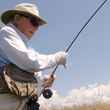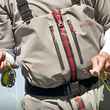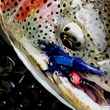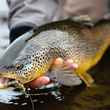Over the last few weeks I’ve been thinking a fair amount about the way hunters fixate on rifles. I’m not really a gun aficionado — it doesn’t matter to me whether my rifle has an embedded stock or a free-floated barrel, or whether a .280 shoots a little flatter than a .270 — but I’m fascinated by the fact that so many hunters focus on all the tiny details that go into a functional firearm. After all, a gun is just a tool — and last I checked, the majority of hunters are neither engineers nor tool-makers.
When I compare how we view our rifles and fly rods … well, it just seems like they’re worlds apart. Fly fishers don’t spend hours and hours delving into raw technical data on rod tapers, or tip deflection, or the optimum specs for a machined reel seat. You won’t find fly fishing writers waxing poetic about a particular epoxy, or the world’s ultimate prepreg, or whether woven scrims are ultimately superior to all other options. Heck, it’s even rare to run across a spirited discussion about ferrules. (Is anyone still using internal spigots, or has the entire industry gravitated to a tip-over-butt design?)
I find it fascinating that the same outdoor enthusiasts who spend an inordinate amount of time delving into the details of rifle design and performance will turn around and buy a fly rod simply because a marketing campaign claims it’s the best thing since sliced bread. When a company tells you that their new rod will increase your casting pleasure, help you catch more fish, and make your teeth whiter, brighter and more attractive, you should respond with a little extra skepticism.
Which begs a simple question. If you shouldn’t trust the advertising — and you shouldn’t — how should you go about purchasing your next fly rod? Here are my suggestions.
First, ignore the marketing hype. Sure, if iconic anglers like Craig Mathews, Kirk Deeter or John Juracek write wonderful things about the new rod from Brand X, then pay attention. But when a really compelling ad makes you reach for your wallet, remember that a new fly rod will not make you a better caster, or a better angler, or increase your piscatorial enjoyment by a factor of ten. We all love to cast nice rods, but a great caster with a mediocre fly rod will always outperform a mediocre caster with a great rod.
Oh, and ignore the price. What do I mean by that? Well, as most expert anglers will tell you, when it comes to fly rods there’s no direct correlation between price and performance. You can spend a lot of money and end up with an incredible rod. You can spend far less money and get an almost-as-incredible fly rod. And you can spend a ton of cash on an absolute clunker. Establish your price ceiling for a new rod, but don’t feel that you have to hit your upper limit. More money does not necessarily equate to a better casting or angling tool.
Then ask yourself what you want your new rod to do — and be specific. Where will you use it? Which species will you target? What type of flies will you fish? Do you anticipate lots of wind? Will you bring your new rod on airplanes? What techniques will you employ? Unless you’re looking to throw your money away, buy a rod that fills a specific need.
Let’s say I want to fish dry flies on New York’s Beaverkill and Delaware rivers, but I don’t have a stellar dry fly rod. I’ll start my search by narrowing down my options to a certain weight and length, with a rod action that’s appropriate for dry fly fishing. For me, that means a 9’ 4 weight with a medium or medium-fast action.
Or let’s say I want to stick with dry flies, but I want to fish Montana’s Yellowstone and Missouri rivers. I’d keep the 9’ length, and the same medium or medium-fast action, but I’d bump up to a 5 weight to handle the extra wind and the potential for bigger flies. When I buy a rod, I want it to either solve a specific angling problem or perform significantly better than a rod I already own.
Once I’ve settled on a length, line weight and action, I set an upper limit on the price and eliminate any models that exceed my limit. Then I decide whether I want to go new or used, and whether to opt for custom or mass-produced, and whether the ubiquitous 4 piece configuration makes more sense than the other options.
Now it’s time to do some research. Since there are folks in the fly fishing media who I trust, I’ll see which rods they’re recommending. And since there are certain brands that I tend to put up on a pedestal, it’s time to find out which of their rods match my specific parameters.
I always want to narrow things down as much as possible before I start visiting local fly shops and asking to test-drive the models that might be a good fit.
I’ll eventually try to cast every rod that meets my parameters (or at least every rod I can find), with an eye towards the specific angling conditions I anticipate. There’s no point taking a flats rod out on the fly shop lawn and seeing if I can make a delicate presentation at 15 feet, or grabbing a spring creek rod and trying to shoot the entire line. And it’s important to spend enough time with a rod to get a good feel for it.
Ultimately, I’ll need to make my decision. My own personal criteria are pretty simple. I want a rod that performs extremely well at the tasks I’ll ask of it, and I want a rod that disappears in my hand.
Some of you may be asking how a rod can “disappear?” Well, the rod should be smooth enough, and accurate enough, and easy enough to cast that I never have to think about it. My focus should always be on my fishing. If I want the fly to land next to a partially submerged log that’s 60’ away, or underneath an overhanging branch, then that’s what should happen — and it should happen with no conscious thought or extra effort on my part. In other word, the rod should vanish from my awareness and I should be left to focus completely on my fishing.
So that, in a nutshell, is my process for choosing a new rod. Is my approach fool-proof? Sadly, no. Picking a new rod is still more art than science. But if we’re willing to take the time, we can eliminate the vast majority of potential issues and give ourselves an excellent shot at finding a fly rod we’ll enjoy for years to come.































Comments
Tracy Parker replied on Permalink
Thanks for taking the time on your article about choosing a fly rod. I'm a true beginner and have spent a ton of time pouring over the numerous choices out there. It's been a bit overwhelming. Thanks again
Nigel Whittingham replied on Permalink
Often it takes a bit of time to get used to a new rod - to understand its capabilities and limits. So be patient and work with the rod, until you understand each other and become a strong fishing partnership. Nigel
Buddy Atwell replied on Permalink
I don't like to be critical, I make a lot of mistakes myself, and I am sure the Author had good intentions. However, I think the reader looking for help will be more confused, than before he read the article. He did make some good points about the "ads", many buyers knowledge is limited to what they read in ads.
William Hoyerman replied on Permalink
No mention of sustainability eco conscience manufacturer, warranty, past history, and not a word on made or assembled in USA. Fly rods are made with some sophisticated chemicals, eyes are plated, cork is rarely sustainable, etc. Otherwise, I totally agree.
Bill A replied on Permalink
Interesting article. A couple of years back, I was looking for a small stream, lightweight rod. Tried a few at the fly fishing show. After a few casts on one rod, I was sold. It was not the most expensive, but it just felt right. So, my advice - try before you buy. And the fly fishing show has a wide variety of rods and a great "pool" for trying them out.
Eric replied on Permalink
Well done. My experience: get some lessons-they are cheaper than a low end fly rod! Perfect those drills and practice… especially practice if you fish salt water… , fish more… find your weaknesses, go back to lessons. Find a new casting instructor for the type of fishing you do. Practice more. Onward to “perfection” with a rod your budget will allow. Guides needn’t apply.
Nigel Whittingham replied on Permalink
I left a comment and you didn’t publish it. Problem? Disappointed.
Don Andersen replied on Permalink
Casting well is but one issue. What about the components used, handle design etc. What is the point of a well casting rod whose guides wear out in 50 hours of use.
Pages